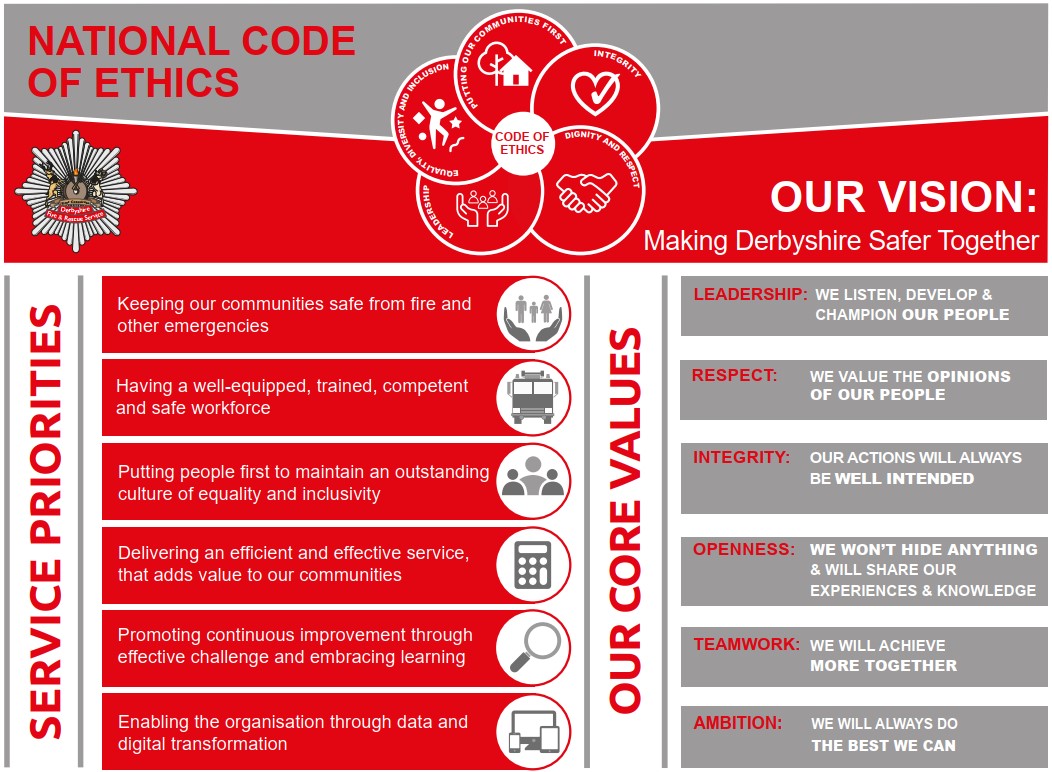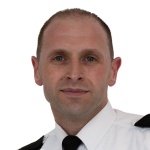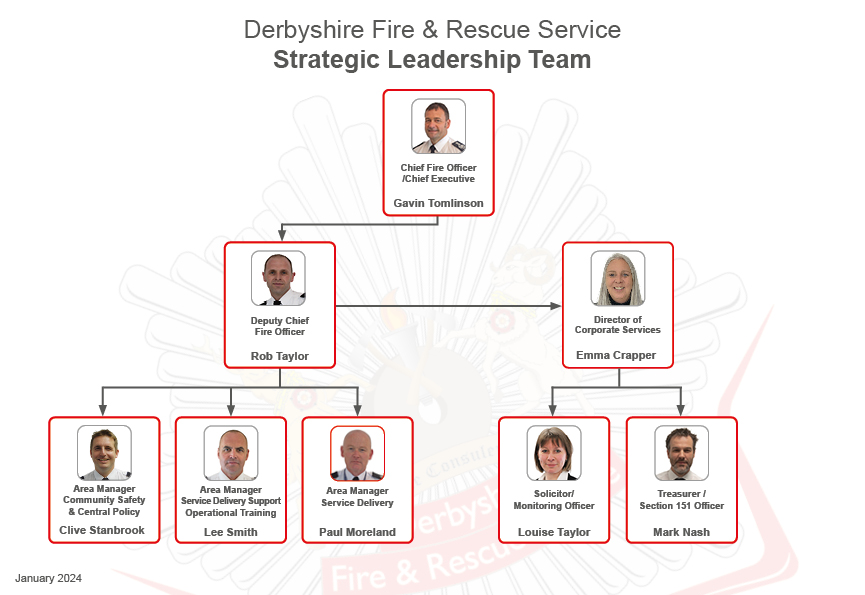Who we are
Derbyshire Fire & Rescue Service covers over 1,000 square miles, which includes a variety of urban and rural communities with a population of approximately 1,050,000.
Derbyshire Fire & Rescue Service covers over 1,000 square miles, which includes a variety of urban and rural communities with a population of approximately 1,050,000.

The Service currently employs approximately 342 wholetime firefighters, 322 On-Call duty system firefighters, 38 Command and Control personnel and 176 support personnel. The Services operates and maintains 31 fire stations, three area offices and the Services joint headquarters in Ripley, Derbyshire.
The Services governing body is the Derbyshire Fire & Rescue Authority.
The Service is headed by the Chief Fire Officer and Chief Executive and the Strategic Leadership Team. Its work is split into the following areas - Community Safety, Response Delivery and the supporting portfolios of Operational Training (Policy and Assurance), Property and Corporate Services, People and Organisational Development, Corporate Financial Services. Each of these areas is the responsibility of an Area Manager apart from Corporate Financial Services which is the responsibility of our Section 151 Officer.
The Strategic Leadership Team (SLT) at Derbyshire Fire & Rescue Service helps set the organisation's strategy and monitors the performance of the organisation. The team meets formally on a regular basis to discuss strategic internal issues as well as the impact that national issues have at a local level.
The SLT consists of the Chief Fire Officer/Chief Executive, Deputy Chief Fire Officer and Area Managers.

Gavin Tomlinson
Chief Fire Officer / Chief Executive
Gavin Tomlinson's Bio
Gavin Tomlinson
Chief Fire Officer / Chief Executive
Chief Fire Officer Gavin Tomlinson commenced his career with Derbyshire Fire & Rescue Service in 1993 as a Recruit Firefighter.
Over the last 20 years Gavin has served in many areas including operational station command, fire safety, learning and development and prevention.
In 2010 he was promoted to Area Manager responsible for Community Safety and the Tri Service Control project. In November 2015 Gavin was promoted to Deputy Chief Fire Officer.
Gavin was promoted to his current role as Chief Fire Officer/Chief Executive in September 2019.

Rob Taylor
Deputy Chief Fire Officer
Rob Taylor's Bio
Rob Taylor
Deputy Chief Fire Officer
Deputy Chief Fire Officer Rob Taylor commenced his Fire Service career in 2001 in Greater Manchester. He transferred to Derbyshire in December 2008 where he served at Buxton Fire Station as a Firefighter.
He was promoted to Crew Manager in 2010 and in 2013 took an On-Call Watch Manager role at Buxton.
In January 2016 he was promoted to Watch Manager at Buxton and in December 2016 was promoted to Station Manager Ops Training.
In March 2017 he was promoted to Group Manager Prevention and Inclusion.
In April 2019 he was promoted to Area Manager Community Safety and in 2020 he was made responsible for Service Delivery.
Rob was promoted to his current role as Deputy Chief Fire Officer in August 2021.

Emma Crapper
Director of Corporate Services
Emma Crapper's Bio
Emma Crapper
Director of Corporate Services
To be completed.

The Community Safety Portfolio is made up of two distinct areas that cover all of the Services prevention and protection activities.
This area of work encompasses a range of activities which are focused on the safety of our diverse communities in their homes, on the road and at leisure. Some of this work is carried out with partner organisations where responsibilities overlap. In Derbyshire, this work includes:
Engaging with and hosting inclusion and positive action events, to communicate with our diverse communities and recruit potential firefighters of the future
You can read more about our varied work with our partners by visiting our community work section. More detail about the Services Inclusion and Equality work and achievements can be found in our Inclusion and Equality section.
This area of work centres on the duties of Derbyshire Fire & Rescue Service (DFRS) under the Regulatory Reform (Fire Safety) Order 2005 and the Fire and Rescue Services Act 2004.
DFRS has a duty to enforce the Order in non-domestic premises within the county. The Order is designed to protect people from fire. Individuals and groups who have control over premises are now responsible for making sure people in or around them are not at risk from fire and its effects.
The Order also includes powers to make sure that facilities within premises that are there to help firefighters in their work are maintained and available.
There are a range of options open when breaches or potential breaches of the Order are identified. These range from advice and agreed action plans through to alteration, enforcement and prohibition notices and, in other circumstances, prosecutions.
Except for single private houses, all work on buildings that are subject to building control legislation requires building control authorities to consult DFRS. These consultations range from projects such as alterations to the entrance hall in a small nursery school, to the major refurbishment and extension of a city centre shopping complex or a multi storey hospital. None of these places should be constructed, occupied and managed in a way that puts people in or around them, at an unacceptable exposure to the risk of harm if a fire occurs.
In the largest and most complex premises, specialist fire engineers develop solutions bespoke to the premises structure and use. These solutions have to be verified by this group and this is managed by running computer simulations of fire growth within them. These computer simulations have proved invaluable in demonstrating how a fire would behave and how a building would perform if a fire occurred. These models are also used to recreate events to assist in fire investigation.
Fire investigation is another role within the Protection work area and, in Derbyshire, co-ordinates local and regional intelligence to advise and support fire investigation officers, working closely with the police. Within this area is the regionally funded Fire Investigation Dog and Handler and the Regional Fire Investigation Coordinator.
For information on how your business can support the work of the DFRS and for fire safety advice for business click visit our Fire Safety for business section.
This is the area of work that is most visible to the public. It is where people see fire appliances responding to incidents and dealing with fires, attending road traffic collisions, and other rescue situations, often on the county's roads.
To enable Derbyshire Fire & Rescue Service (DFRS) to respond to incidents, the county has been split into three areas. These are split along council boundaries and are:
The response area of work for DFRS also includes making sure the response of the service is matched to identified needs in local communities, such as large industrial premises, historic buildings or areas of high population, and making sure that an effective operational response is maintained at all times.
Response also takes into consideration researching operational response nationally to make sure that good practice is taken into account and developing that to meet the needs of local communities.
To cover the county, DFRS has a total of 31 fire stations based in strategic areas to cover the risk of the local area. To find out more about a station, see the fire stations section.